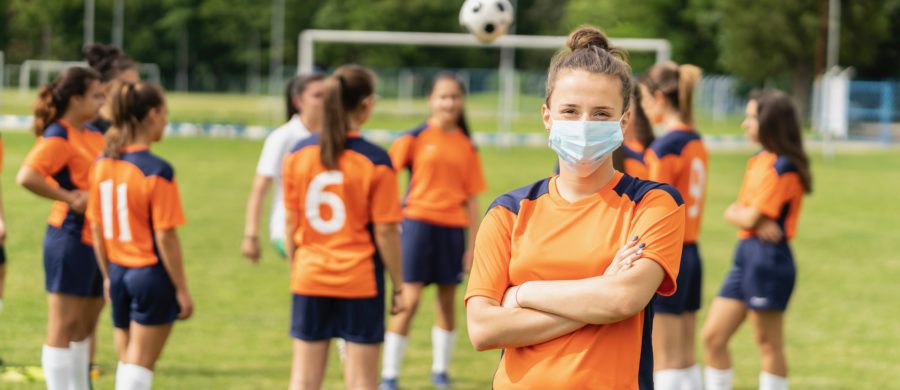As summer approaches, it is time to start scheduling fall middle and high school pre-participation sports physical examinations. This article explains the reasoning around the sports physical, how to prepare, and what to expect. Providers are also screening for additional risks with those who have had Covid-19.
Why is a child’s sports physical important?
A child’s sports physical goal is to ensure that participating in their athletic endeavors is safe. Our goal as medical providers is to:
- Identify life-threatening risks to participation;
- Address underlying health issues that could worsen with physical activity;
- Discuss previous injuries;
- Treat conditions that could interfere with performance;
- Provide appropriate patient-specific recommendations and restrictions;
- Eliminate any previously placed restrictions that are unwarranted.
Schedule Physicals Now for Fall Sports
While medical providers conduct sports physicals throughout the year, a high proportion of wellness visits and pre-participation sports physicals are completed during the summer months. This is why it’s important to schedule a visit now for fall sports.
The American Academy of Pediatrics (AAP) recommends that physicals occur at least 6 to 8 weeks before the athletic season so that further evaluation (e.g., EKG or cardiology or orthopedic consultation) can be completed before the season. Also, the AAP recommends that these visits be scheduled once a year before the child’s upcoming athletic season.
Choosing a Provider for Your Child’s Sports Physical
We recommend that the sports physical be conducted in your child’s medical home (with your primary care pediatrician or family medicine provider) rather than an urgent care or “station” setting where group/mass physicals are performed. This ensures that the provider has full access to your child’s medical records, previous knowledge of their history and that proper privacy and confidentiality is maintained during the medical visit.
It is often possible to complete a sports physical during the annual wellness visit with your child’s primary care provider. Although the evaluation content covered during the wellness exam and a sports physical is not typically the same, many providers will complete all of the content in the same visit. Just ask your nurse and/or physician. Completing both exams may take extra time. Be aware that your provider might ask you to schedule a follow-up visit to cover specific concerns that they cannot address during a combined wellness/sports physical evaluation.
How to Prepare for a Sports Physical
To get the most from your child’s physical exam visit, come prepared to discuss any concerns, including:
- Physical and mental health questions;
- Past injuries and chronic medical conditions that physical activity may exacerbate, such as exercise-induced asthma;
- Pertinent family history. Specifically, your provider is interested in a family history of muscle/bone/joint problems, anemia, heart murmurs/rhythm, and valve problems, fainting, hypertension, or family history of sudden death;
- History of head injuries and concussions. It’s critical to discuss a plan for a head injury and concussion care and clearance protocols to return to play should a concussion occur in the future.
What happens during a sports physical?
During a thorough sports physical visit, the medical provider will:
- Conduct a comprehensive physical examination with attention to the cardiovascular and musculoskeletal systems;
- Obtain a medical history, including family history as well as screening for mental health problems, such as depression;
- Discuss the use of drugs, alcohol, smoking, and sexual history (if appropriate).
While rare, sometimes a concern may arise that requires additional evaluation. For instance, if your provider discovers a new murmur or heart rhythm issue, they may refer your child to a pediatric cardiologist or order an EKG. Another example is if a provider learns of chest pain, palpitations, or fainting, they may refer to a cardiologist for consultation. In cases of musculoskeletal injury, your provider may recommend consulting with an orthopedist or physical therapist.
COVID-19 and the Sports Physical
During the Covid-19 pandemic, we learned that having the virus increases the risk of heart problems in children and adolescents. For this reason, there are Covid-specific screening protocols in place to help provide appropriate clearance to participate in sports. For this reason, it is important to let your provider know if your child has had Covid so that this specific screening can occur. As we learn more about the virus and its effects on the heart and cardiovascular system, screening and clearance protocols will continue to evolve.
As a side note, we are hopeful that vaccinations will enable many more children to get back to playing the sports they love!
Resources:
Welcoming new patients with same- and next-day appointments available.
Schedule your child’s sports physical and well-child visits today.

Dr. Jim Gottlieb is one of 12 board-certified pediatricians at Boulder Medical Center.
The board-certified pediatricians at Boulder Medical Center are committed to providing personal, high-quality, and compassionate health care to present and future generations, from newborns to young adults. With clinics in Boulder, Louisville, Erie, and Longmont, we’re conveniently located in your neighborhood.
Meet our providers and make an appointment with a Boulder Medical Center pediatrician.

